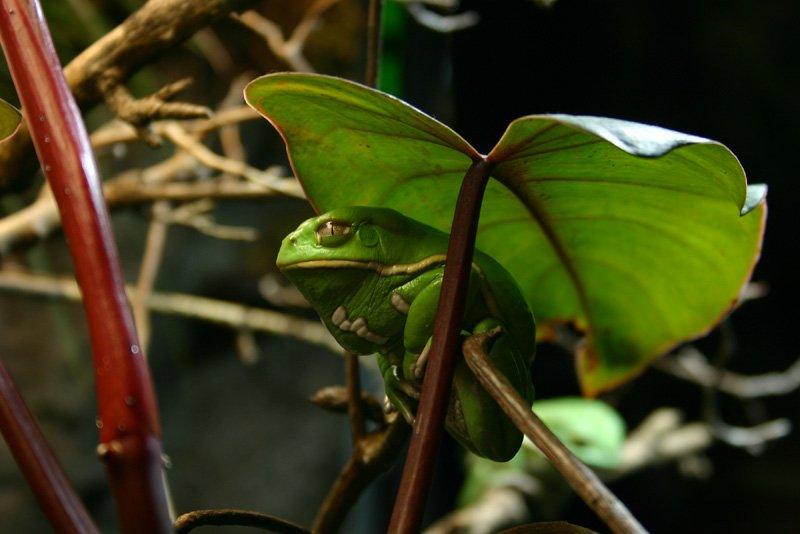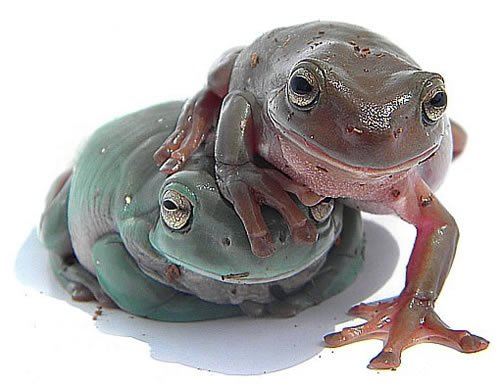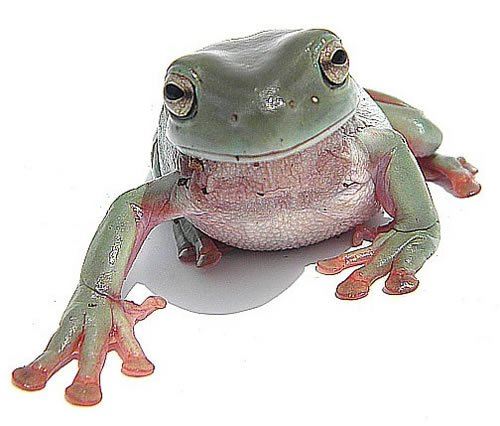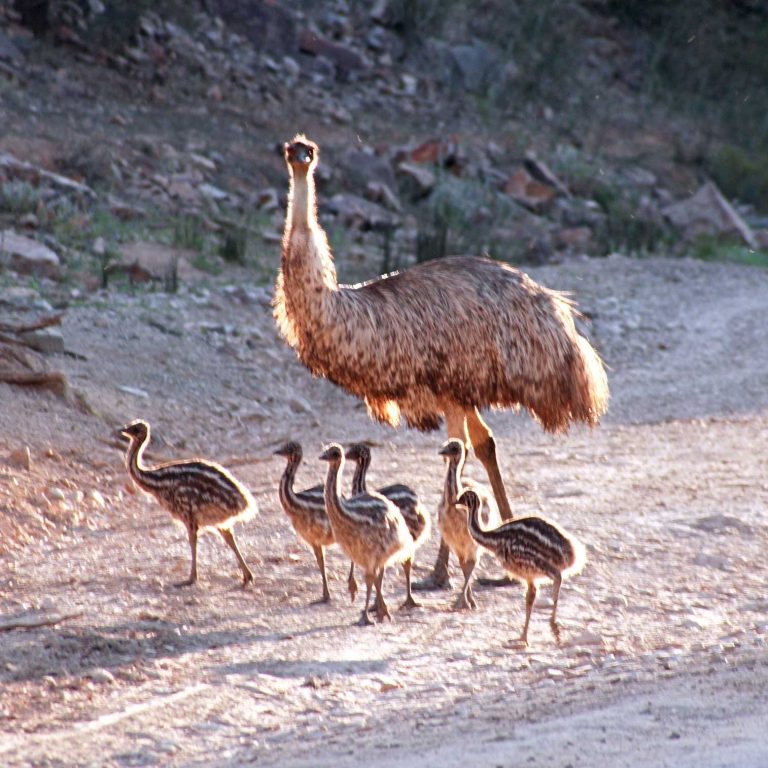Whites Tree Frog
Care Sheet
| Size: | About 4 inches |
| Expected Life Span: | up to 21 years |
| Lifestyle: | Arboreal (lives in trees) |
| Level of Care: | Hardy, Good for beginners |

General Appearance:

This frog ranges between bluish-green, light green, and brown in color. Its color will change with the temperature and the color of its habitat – a master of camouflage. They are green when the humidity and temperature are high, and darker in appearance with a brownish color in cold, arid conditions.
They have a wax-like coating over their skin. This helps the Whites Tree Frog retain moisture and survive in areas of lower humidity than its natural habitat.
The White’s Tree Frog gets its nickname “Dumpy” Tree Frog because it has a tendency to become obese if it is overfed. In the wild, they would have to hunt for their food and their prey tends to have a lot more opportunities to escape than in the confines of your habitat. Hence, they have a tendency to add a few layers of fat on the back of their heads, which gives them the telltale Dumpy look.
You can normally tell the age of this frog by the number of white spots they have on their bodies. They develop more and more of these irregular shaped spots as they grow older.
*Always Wash Your Hands Both Before And After Handling Frogs or their Habitat*
Know your Frog:
Knowing your frog and understanding how to cater to its unique needs is important when you get one as a pet. They are called a ‘pet’ but frogs are not actually a pet you ‘play with.’ Rather, they are to be appreciated in the habitat similar to watching a fish tank.
The Whites Tree Frogs are highly arboreal, meaning they like to climb. So your habitat includes good things to climb on. They also like high humidity so keep the clear water dish full of clean water for frog soaking and keeping the humidity up.
The Whites Tree Frog is delicate and does not like to be touched too often. This will make them feel threatened and this distress leads to illness; so do not touch them unnecessarily. Your lotion or even the oils in your skin can do a lot of harm to the frog.
Whites Tree Frogs are arguably the most preferred pet frog across the globe. It is liked for its calm nature, funny appearance, longevity, resistance to disease and minimal care requirements. If your Whites Tree Frog has folds of flesh over its eyes, you can be sure he has done justice to his nickname Dumpy Tree Frog. This normally means that you need to cut down on his feed a little so he can lose some of the excess weight.
Feeding:

These frogs need to eat 2 to 3 times a week. The Whites Tree Frogs are not particular on their food…if it moves and they can catch it, they will happily eat it. They do need movement to recognize food, so they will not eat dead food sources. Crickets, worms and other small creepy crawlies form the bulk of the frog’s diet. They can recognize routine –if you feed them at the same time every day you’ll start to find them waiting for their lunch. Any uneaten prey should be removed from the enclosure the next day to prevent dead insects from polluting the frog’s environment. Every-other feeding sprinkle a little calcium or multivitamin powder onto the bugs before you drop them into the habitat. We have included some calcium powder for you. Tree frogs are susceptible to calcium deficiencies that can lead to metabolic bone disease if they are not given supplemented calcium and variety within their diet. You can get bugs and more calcium powder from the pet store.
Overfeeding can result in obesity in the Whites Tree Frog. You must be very careful to monitor its appearance to check for signs of obesity. Typically they tend to grow fat and start growing folds of flesh just above their eyes. If the obesity increases, you can find these folds drooping over their eyes. When they become obese, the Whites Tree Frogs have a Dumpy appearance giving them the name Dumpy Tree Frog. They might also tend to slow down and not be as active if they are overfed. If you notice those folds of flesh, you should put the frog on a diet (reduce the bug quantity).
Caring for Whites Tree Frogs:

First and foremost, remember that your little Tree Frog is a big jumper…you want to make sure you keep the lid firmly on your frogs habitat at all times.
Temperature: Frogs are cold-blooded, meaning they can’t regulate their body temperature on their own. A heater is not usually necessary as these frogs are comfortable in room temperature, but if your home is cold you should consider a small heat light for extra warmth.
Humidity: These frogs like high humidity. You can help keep the humidity high by using the mister to spray the habitat with treated water once a day or more. Air conditioners lower the humidity of the room so if you have one on, you must give your frog’s habitat a few more sprays of water to make sure he doesn’t get dehydrated.
Cleaning:

Make sure the habitat is always clean by changing the water once a week and rinsing the habitat contents. Dirty water can cause the frogs to get sick. When you move the frog into another container to clean his habitat, gently lift him with your fingers being careful not to poke, pinch or squeeze him. You must also be very careful when you clean your Whites Tree Frog’s habitat. They are extremely sensitive to soaps and detergents. Using only hot water, rinse the habitat, carpet, moss and other props in your habitat and then add new de-chlorinated room-temperature water to the clear water dish. Let the water sit out for 2 hours to become room temperature before adding the frog back into the habitat. Always wash your hands after handling the habitat contents. The moss will last for around 4 cleanings. We have included around 3 months of moss for you based on doing weekly cleanings. You can use any pet store water de-chlorinator and moss after you run out of what came with your habitat.
What if I can no longer care for my Frog?

These frogs live a long time. If there’s ever a reason you can no longer take care of it, please do not release the frog outside. He can not survive outside temperatures and he may not have learned to hunt on his own. Some suggestions: find a friend or neighbor who would like a pet frog, or donate it to a school for a wildlife display, or give it to a local pet shop who can possibly find it a home.













Having discovered a fondness for insects while pursuing her degree in Biology, Randi Jones was quite bugged to know that people usually dismissed these little creatures as “creepy-crawlies”.







